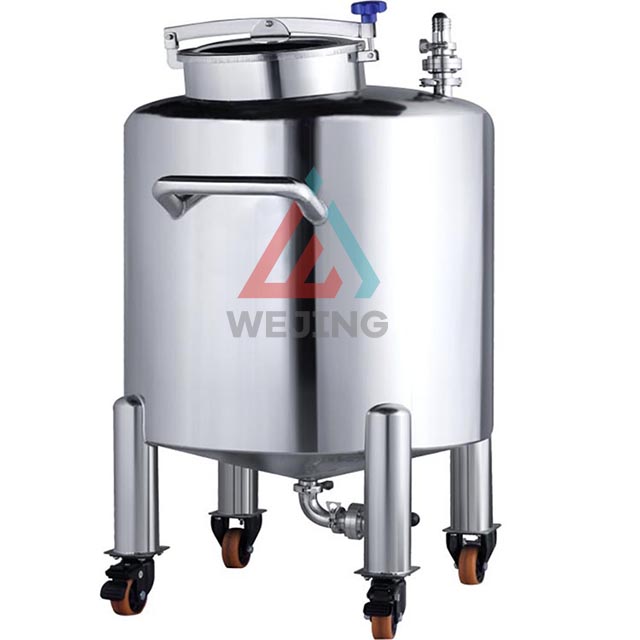
Product Advantage:
1. Corrosion resistance: Stainless steel has excellent corrosion resistance and can resist the erosion of most chemicals. This makes stainless steel storage tanks suitable for storing various corrosive liquids, such as acids, alkalis, saltwater, etc.
2. Durability: Stainless steel storage tanks have high strength and durability, and can withstand high pressure and temperature. Their service life is usually longer than tanks made of other materials, reducing the cost and frequency of equipment replacement.
3. Easy maintenance: The stainless steel surface is relatively easy to clean and does not require special maintenance and upkeep. Regular simple cleaning and inspection are necessary to maintain the good condition of the storage tank.
4. Aesthetics: Stainless steel storage tanks have a bright appearance, and the surface can be polished or coated to make it look more beautiful and high-end. This is very suitable for some occasions that require appearance.
Technical Parameters:
Distributed | Materials and Parameters | Instructions |
Pot body | Full pot capacity: 200L, working capacity 230L, pot body thickness of inner layer 2MM | Connecting the bottom of the lower cone to the pot body and reinforcing the welding of the upper head |
Opening method | Pressure manhole cover, equipped with cleaning ball, respirator, feeding port, pressure gauge, safety valve |
|
Fixed method | Fixed with 4 89 diameter 1.5-thick 304 round pipes |
|
Movable method | Equipped with 4 4-inch global mobile wheels and a handle on the pot body | 2 fixed and 2 universal joints |
Foot connection board | 304 material 4cm stainless steel plate | Fixed moving wheel |
Discharge | Place ingredients at the bottom of the pot and discharge them in a hygienic manner | 51 butterfly valve |
Product Uses:
1. Petroleum and chemical industry: Stainless steel storage tanks are used in the petroleum and chemical industry to store various liquids and chemicals, such as crude oil, gasoline, diesel, acid-base liquids, etc. The corrosion resistance and high temperature resistance of stainless steel make it an ideal choice in this field.
2. Food and beverage processing: Stainless steel storage tanks are used in the food and beverage processing industry to store and process liquid foods, such as milk, juice, beer, soy sauce, etc. The hygiene and corrosion resistance of stainless steel ensure the safety and quality of food.
3. Pharmaceutical industry: In the pharmaceutical industry, stainless steel storage tanks are used for storing and distributing pharmaceutical raw materials, intermediates, and finished products. The material of stainless steel meets strict hygiene standards, ensuring the purity and quality of drugs.
4. Water treatment: Stainless steel storage tanks are commonly used in water treatment systems to store and treat drinking water, wastewater, and sewage. They can effectively prevent water pollution and ensure a safe supply of water.
5. Industrial production: Stainless steel storage tanks are used in industrial production to store various industrial liquids, such as lubricating oil, antifreeze, solvents, etc. The corrosion resistance and high temperature resistance of stainless steel enable it to adapt to different industrial environments.
Operate Guide:
1. Installation and Placement
Before installing the stainless steel storage tank, please ensure that the foundation is flat, sturdy, and able to withstand the weight of the tank.
When installing, please follow the installation instructions provided by the manufacturer to ensure that all connections are properly sealed.
Storage tanks should be placed in well ventilated areas, away from direct sunlight, and away from sources of fire and flammable materials.
2. Filling and emptying
Before filling the stainless steel storage tank, please make sure to understand the properties of the stored material and relevant safety regulations.
When filling, avoid exceeding the maximum capacity of the storage tank and follow the filling procedure provided by the manufacturer.
When emptying the storage tank, relevant safety regulations should be followed to avoid static electricity and leakage.
3. Maintenance and upkeep
Regularly inspect the appearance of the storage tank to ensure that there is no corrosion, cracks, or other damage.
Check the sealing condition of all connections and promptly repair any leaks.
Regularly clean the interior of the storage tank to avoid the accumulation of dirt and impurities.
According to the manufacturer's recommendations, perform regular maintenance and upkeep on the storage tank.

















